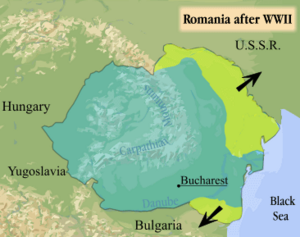Romania in World War II facts for kids
The Kingdom of Romania, led by King Carol II, first tried to stay out of World War II. But Fascist groups, especially the Iron Guard, grew strong. They wanted Romania to join Nazi Germany and its allies. When France and Britain, who had promised to protect Romania, were defeated in the Fall of France (May-June 1940), Romania looked to Germany for help. They didn't know that Germany had already agreed with the Soviet Union in a secret deal (the Molotov–Ribbentrop Pact) that the Soviets could claim Romanian land.
In the summer of 1940, the USSR took over Bessarabia and Northern Bukovina. Then, in August and September 1940, Germany and Italy made decisions about two land disputes that went against Romania. Romania lost Northern Transylvania to Hungary and had to give Southern Dobruja to Bulgaria. People were very unhappy with the Romanian government. This made fascist and military groups even stronger. They took over in September 1940, making the country a dictatorship under Mareșal Ion Antonescu. The new government officially joined the Axis powers on November 23, 1940.
As an Axis member, Romania joined the invasion of the Soviet Union on June 22, 1941. Romania gave equipment and oil to Nazi Germany. It also sent more soldiers to the Eastern Front than all other German allies combined. Romanian forces fought bravely in Ukraine, Bessarabia, and the Battle of Stalingrad. Sadly, Romanian troops were also involved in the persecution and killing of 260,000 Jews in areas they controlled. However, half of the Jews living in Romania itself survived the war. Romania had the third-largest Axis army in Europe and the fourth-largest in the world, after Germany, Japan, and Italy. After Italy left the Axis in September 1943, Romania became the second main Axis power in Europe.
The Allies bombed Romania starting in 1943. Soviet armies invaded the country in 1944. People in Romania no longer supported the war. The German-Romanian battle lines broke under the Soviet attack. King Michael of Romania led a coup that removed Antonescu's government in August 1944. This put Romania on the side of the Allies for the rest of the war. (Antonescu was executed in June 1946). Even though Romania joined the winning side late, the larger Romania from before the war was not fully restored. However, the country did get back Northern Transylvania from Hungary.
Contents
Why Romania Joined the War
After World War I, Romania, which fought with the Allies, gained a lot of land. It took over regions like Transylvania, Bessarabia, and Bukovina. This happened because the Austro-Hungarian and Russian empires had fallen apart. This helped Romania achieve its dream of a "Greater Romania" – a country for all ethnic Romanians.
However, these new lands also had many Hungarian, German, Bulgarian, Ukrainian, and Russian people. This caused problems with Romania's neighbors. Sometimes, these problems led to fights, like the Hungarian–Romanian War. To stop Hungary from trying to take back land, Romania, Yugoslavia, and Czechoslovakia formed the Little Entente in 1921. That same year, Romania and Poland made a defensive alliance against the new Soviet Union. In 1934, the Balkan Entente was formed with Yugoslavia, Greece, and Turkey, who were worried about Bulgaria.
Since the late 1800s, Romania had been a fairly democratic constitutional monarchy with ties to Western countries. But in the 1930s, the country faced more problems. The Great Depression in Romania hit hard, and fascist groups like the Iron Guard grew. These groups used violence against the government. King Carol II took more power in 1938, saying it was to stabilize the country. His new government had policies similar to Fascist Italy and Nazi Germany. At the same time, economic pressures and a weak response from France and Britain to Hitler's aggressive actions made Romania move away from the Western Allies and closer to the Axis.
On April 13, 1939, France and the United Kingdom promised to protect Romania's independence. Talks with the Soviet Union about a similar promise failed because Romania would not let the Red Army cross its borders.
On August 23, 1939, Germany and the Soviet Union signed the Molotov–Ribbentrop Pact. A secret part of this deal said the Soviet Union was interested in Bessarabia, which had been ruled by Russia from 1812 to 1918. It also clearly stated that Germany had no interest in that area.
Eight days later, Nazi Germany invaded Poland. Poland expected military help from Britain and France. Poland chose not to use its alliance with Romania so it could use the Romanian Bridgehead as an escape route. Romania officially stayed neutral. Under pressure from the Soviet Union and Germany, Romania held the fleeing Polish government after they crossed the border on September 17. This forced them to give their power to the Polish government-in-exile. After Romanian Prime Minister Armand Călinescu was killed on September 21, King Carol II tried to stay neutral for several more months. But when France surrendered and British forces left Europe, the promises from both countries to Romania became meaningless.
In 1940, Romania lost most of the land it had gained after World War I. In July, after the Soviets gave an ultimatum, Romania agreed to give up Bessarabia and northern Bukovina. The Soviets also took the city of Hertsa, which was not in the ultimatum. Two-thirds of Bessarabia were combined with a small part of the Soviet Union to form the Moldavian Soviet Socialist Republic. The rest (northern Bukovina, northern Hotin county, and Budjak) went to the Ukrainian Soviet Socialist Republic.
Soon after, on August 30, Germany and Italy helped Romania and Hungary reach a deal called the Second Vienna Award. Hungary received a region called 'Northern Transylvania', while 'Southern Transylvania' stayed part of Romania. (Hungary had lost Transylvania after World War I in the Treaty of Trianon). On September 7, under the Treaty of Craiova, Southern Dobruja was given to Bulgaria. Bulgaria had lost this land after Romania invaded during the Second Balkan War in 1913. Even though Romania had gained these lands recently, most people living there were Romanian speakers (except Southern Dobruja). Romanians saw these lands as historically theirs. Losing so much land without a fight greatly weakened King Carol's power.
On July 4, Ion Gigurtu formed the first Romanian government that included a minister from the Iron Guard, Horia Sima. Sima had become the leader of the movement after Corneliu Codreanu died. He was one of the few far-right leaders who survived the violent conflicts and government crackdowns of previous years.
Antonescu Takes Control
Right after losing Northern Transylvania, on September 4, 1940, the Iron Guard (led by Horia Sima) and General (later Marshal) Ion Antonescu joined forces. They formed the "National Legionary State". This forced King Carol II to give up his throne to his 19-year-old son Michael. Carol and his girlfriend Magda Lupescu went into exile. Romania, despite its recent land losses, strongly moved towards the Axis. As part of the deal, the Iron Guard became the only legal political party in Romania. Antonescu became the Iron Guard's honorary leader, and Sima became deputy premier.
Once in power, the Iron Guard made anti-Jewish laws even stricter. They passed laws against minority business owners, though officials sometimes took bribes. They also took revenge on their enemies. On October 8, 1940, German troops began entering Romania. Soon, there were over 500,000 of them.
On November 23, Romania joined the Axis powers. On November 27, 1940, the Iron Guard killed 64 former officials in the Jilava prison while they waited for trial (this was the Jilava Massacre). Later that day, historian and former prime minister Nicolae Iorga and economist Virgil Madgearu, a former government minister, were also killed.
The Iron Guard and Antonescu never got along easily. On January 20, 1941, the Iron Guard tried to take over the government. This was combined with a violent attack against Jews in Bucharest (the Bucharest pogrom). Within four days, Antonescu successfully stopped the coup. The Iron Guard was forced out of the government. Sima and many other members fled to Germany; others were put in prison. Antonescu ended the National Legionary State and instead declared Romania a "National and Social State."
Fighting on the Eastern Front
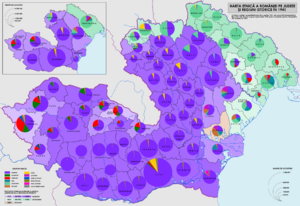
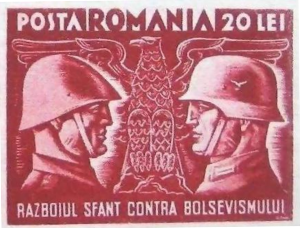
On June 22, 1941, German armies, with huge support from Romania, attacked the Soviet Union. German and Romanian units took over Bessarabia, Odessa, and Sevastopol. Then, they marched east across the Russian plains towards Stalingrad. Romania welcomed the war because it allowed them to take back lands the Soviet Union had taken a year earlier. Hitler rewarded Romania's loyalty by giving back Bessarabia and northern Bukovina. He also let Romania manage Soviet lands between the Dniester and the Bug rivers, including Odessa and Nikolaev. Romanian nationalists in Odessa even handed out maps showing that ancient Dacians had lived in most of southern Russia. After getting back Bessarabia and Bukovina (Operation München), Romanian units fought alongside the Germans towards Odessa, Sevastopol, Stalingrad, and the Caucasus.
The total number of Romanian troops involved on the Eastern Front, with the Romanian Third Army and the Romanian Fourth Army, was second only to Nazi Germany itself. The Romanian Army had 686,258 soldiers in the summer of 1941 and 1,224,691 in the summer of 1944. More Romanian troops were sent to fight in the Soviet Union than all of Germany's other allies combined. A study by the U.S. Library of Congress says this was due to a "fierce competition with Hungary to gain Hitler's favor" in hopes of getting back northern Transylvania.
Bessarabia and Northern Bukovina were now fully part of Romania again after the Soviets had taken them a year earlier. As a replacement for Northern Transylvania, which Hungary had received after the Second Vienna Award, Hitler convinced Antonescu in August 1941 to also take control of the Transnistria area between the Dniester and the Southern Bug rivers. This area would include Odessa after its capture in October 1941. Although the Romanian government set up a civil administration, the Transnistria Governorate, Romania had not officially made Transnistria part of its country by the time Soviet troops took it back in early 1944.
Romanian armies advanced deep into the Soviet Union in 1941 and 1942. Then, they were part of the terrible defeat at the Battle of Stalingrad in the winter of 1942–43. Petre Dumitrescu, one of Romania's most important generals, commanded the Third Army at Stalingrad. In November 1942, the German Sixth Army was briefly placed under Dumitrescu's command. This happened during a German attempt to help the Third Army after the devastating Soviet Operation Uranus.
Before the Soviet counterattack at Stalingrad, Antonescu's government believed a war with Hungary over Transylvania was unavoidable after the expected victory over the Soviet Union. Although it was an ally of Germany, Romania's later switch to the Allied side in August 1944 was rewarded by getting back Northern Transylvania, which had been given to Hungary in 1940 after the Second Vienna Award.
War Reaches Romania
Air Raids

During Antonescu's rule, Romania supplied Nazi Germany and the Axis armies with oil, grain, and factory goods. Also, many train stations, like Gara de Nord in Bucharest, were used to move troops to the Eastern Front. Because of this, by 1943, Romania became a target for Allied air attacks. One of the most famous air raids was Operation Tidal Wave. This was an attack on the oil fields of Ploiești on August 1, 1943. Bucharest was heavily bombed by the Allies on April 4 and 15, 1944. The Luftwaffe (German air force) itself bombed the city on August 24 and 25 after Romania switched sides.
Ground Offensive
In February 1943, with the strong Soviet counterattack at Stalingrad, it became clear that the war was turning against the Axis powers.
By 1944, Romania's economy was ruined because of the war costs. Also, Allied air bombing across the country, including the capital Bucharest, caused much damage. Most products sent to Germany, like oil, grain, and equipment, were given without payment because Germany refused to pay. As a result of these unpaid exports, inflation in Romania soared. This caused widespread unhappiness among Romanians, even those who had once supported the Germans and the war. It also created an angry relationship between Romania and Germany.
Starting in December 1943, the Soviet Dnieper–Carpathian Offensive pushed Axis forces all the way back to the Dniester River by April 1944. In April–May 1944, Romanian forces led by General Mihai Racoviță, along with parts of the German Eighth Army, defended northern Romania. They fought in the Battles of Târgu Frumos. David Glantz believed this was an early Soviet attempt to invade Romania, supposedly stopped by Axis defenses in northern Romania. The Jassy–Kishinev Offensive, launched on August 20, 1944, led to a quick and decisive Soviet breakthrough. It caused the German-Romanian front in the region to collapse. Soviet forces captured Târgu Frumos and Iași on August 21 and Chișinău on August 24, 1944. The important Focșani Gate was invaded on August 27, 1944, by Soviet forces. This allowed them to spread out towards Bucharest, the Black Sea, and the Eastern Carpathians.
Key Moments (Axis Side)
- Romanian engineers helped build the longest bridge ever constructed under fire. This was the bridge over the Dnieper at Beryslav.
- The Romanian capture of Odessa was the most important wartime victory by any smaller European Axis power, achieved without much German help.
- On September 1, 1942, the Romanian 3rd Mountain Division took part in the largest water-based attack by Axis Powers in Europe during the war.
- In late 1942, General Ioan Dumitrache captured Nalchik. This was the furthest point the Axis reached in the Caucasus.
- Romania provided up to 40% of the Axis soldiers in the Kuban Bridgehead. On April 7, 1943, one Romanian battalion restored the front line of an entire German division.
- In May 1944, an entire German army (the 6th) came under Romanian command. This was part of General Petre Dumitrescu's army group. It was the first time German commanders were truly led by their foreign allies in the war.
- Romania received more Knight's Crosses (a German military award) than any other non-German Axis power.
- Ion Antonescu was the first non-German to receive the Knight's Cross of the Iron Cross.
- Mihail Lascăr was the first non-German to receive the Knight's Cross of the Iron Cross with Oak Leaves.
- The Romanian Mareșal tank destroyer is believed to have inspired the German Hetzer tank destroyer.
- Romania captured 2 KV-1 tanks, 1 IS-2 tank, and 1 ISU-152 assault gun. These were the only heavy armored vehicles Romania had during the war. The country's armored forces, even in July 1944, only had medium tanks and assault guns.
-
Romania on February 10, 1947, after the Paris Peace Treaties.
The Holocaust
- See also Responsibility for the Holocaust (Romania), Antonescu and the Holocaust, Porajmos#Persecution in other Axis countries.
According to a report from an international commission in 2004, between 280,000 and 380,000 Jews were killed or died in Romanian-controlled areas during the war. These areas included Bessarabia, Bukovina, and former Soviet lands under Romanian control (Transnistria Governorate). Of the 25,000 Romani (Roma) people sent to camps in Transnistria, 11,000 died.
Much of the killing happened in war zones by Romanian and German troops. But there were also many persecutions behind the front lines. During the Iaşi pogrom in June 1941, over 13,000 Jews were killed or died slowly on trains moving across the countryside.
Half of the estimated 270,000 to 320,000 Jews living in Bessarabia, Bukovina, and Dorohoi County in Romania were killed or died between June 1941 and spring 1944. Between 45,000 and 60,000 Jews were killed in Bessarabia and Bukovina by Romanian and German troops within months of Romania entering the war in 1941. Even after these initial killings, Jews in Moldavia, Bukovina, and Bessarabia faced frequent violent attacks. They were forced into ghettos and then sent to Transnistria, including camps built and run by Romanian authorities.
Romanian soldiers and police also worked with the Einsatzkommandos, which were German killing squads. These squads were tasked with killing Jews and Roma in conquered areas. They also worked with local Ukrainian militias and SS squads of local Ukrainian Germans. Romanian troops were largely responsible for the 1941 Odessa massacre. In this event, from October 18, 1941, to mid-March 1942, Romanian soldiers in Odessa, helped by police, killed up to 25,000 Jews and sent more than 35,000 away.
The exact number of deaths in all areas is not certain. But the lowest reliable estimates are about 250,000 Jews and 11,000 Roma in these eastern regions.
However, half of the Jews living within Romania's borders before the invasion of the Soviet Union survived the war. They faced many harsh conditions, including forced labor, money penalties, and unfair laws. All Jewish property was taken by the state.
The report on the Holocaust, ordered and accepted by the Romanian government in 2004, concluded:
Of all the allies of Nazi Germany, Romania is responsible for the deaths of more Jews than any country other than Germany itself. The killings in Iasi, Odessa, Bogdanovka, Domanovka, and Peciora, for example, were among the most terrible killings against Jews anywhere during the Holocaust. Romania committed genocide against the Jews. The survival of Jews in some parts of the country does not change this fact.
The Royal Coup

On August 23, 1944, the Red Army broke through German defenses during the Second Jassy–Kishinev Offensive. King Michael I of Romania then led a successful coup against the Axis. He had support from opposition politicians, most of the army, and civilians led by the Communists. King Michael, who was first seen as just a figurehead, successfully removed Antonescu's dictatorship. The King then offered the German ambassador Manfred von Killinger a peaceful retreat. But the Germans thought the coup could be reversed and tried to change the situation with military force. The Romanian First, Second (forming), and what was left of the Third and Fourth Armies (one corps) were ordered by the King to defend Romania against any German attacks. King Michael offered to put the Romanian Army, which had nearly 1,000,000 soldiers at that time, on the side of the Allies. Stalin immediately recognized the King and the return of the conservative Romanian monarchy.
In a radio broadcast to the Romanian nation and army on the night of August 23, King Michael announced a cease-fire. He declared Romania's loyalty to the Allies and accepted an armistice (to be signed on September 12) offered by Great Britain, the United States, and the USSR. He also declared war on Germany. The coup sped up the Red Army's advance into Romania. However, it did not stop a quick Soviet occupation and the capture of about 130,000 Romanian soldiers. These soldiers were sent to the Soviet Union, where many died in prison camps. The armistice was signed three weeks later, on September 12, 1944. Its terms were almost entirely dictated by the Soviet Union. Under the armistice, Romania announced its unconditional surrender to the USSR. It was placed under the occupation of Allied forces, with the Soviet Union representing them. The Soviets controlled media, communication, postal services, and civil administration behind the front lines. Some believe the delay in formal Allied recognition of Romania's change of sides until September 12 (when the armistice was signed in Moscow) was due to complex talks between the USSR and the UK.
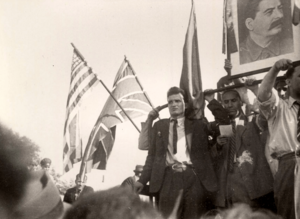
During the Moscow Conference in October 1944, Winston Churchill, the Prime Minister of the United Kingdom, suggested an agreement to Soviet leader Joseph Stalin. This agreement was about how to divide Eastern Europe into areas of influence after the war. The Soviet Union was offered a 90% share of influence in Romania.
Article 18 of the Armistice Agreement of September 12 stated that "An Allied Control Commission will be established. It will manage and control the carrying out of these terms under the general direction and orders of the Allied (Soviet) High Command, acting for the Allied Powers." The Annex to Article 18 made it clear that "The Romanian Government and its bodies shall follow all instructions from the Allied Control Commission that come from the Armistice Agreement." The Agreement also said that the Allied Control Commission would be based in Bucharest. Following Article 14 of the Armistice Agreement, two Romanian People's Tribunals were set up to try suspected war criminals.
Fighting Against the Axis
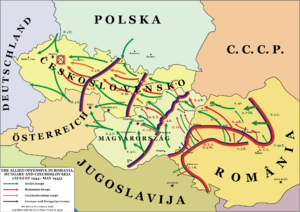
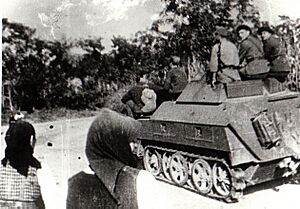
As Romania declared war on Germany on the night of August 23, 1944, border clashes between Hungarian and Romanian troops began almost immediately. On August 24, German troops tried to take Bucharest and stop King Michael's coup. But they were pushed back by the city's defenses. Other German army units in the country suffered heavy losses. The remaining parts of the Sixth Army retreating west of the Prut River were cut off and destroyed by the Red Army, which was now moving even faster. Meanwhile, Romanian units attacked German bases at the Ploiești oilfields, forcing them to retreat to Hungary. The Romanian Army captured over 50,000 German prisoners around this time, who were later handed over to the Soviets.
In early September 1944, Soviet and Romanian forces entered Transylvania. They captured the towns of Brașov and Sibiu as they moved towards the Mureș River. Their main goal was Cluj, a city seen as the historical capital of Transylvania. However, the Second Hungarian Army was in the region. Along with the Eighth German Army, they fought the Allied forces on September 5, 1944. This became the Battle of Turda, which lasted until October 8 and caused many casualties on both sides. Also around this time, the Hungarian Army carried out its last independent attack of the war, entering Arad County in western Romania. Despite early success, some temporary Romanian cadet battalions managed to stop the Hungarian advance at the Battle of Păuliș. Soon, a combined Romanian-Soviet counterattack overwhelmed the Hungarians, who gave ground and left Arad on September 21.
The Battle of Carei marked the final step in getting back Romania's former territory of Northern Transylvania. This land had been given to Hungary in 1940 due to the Second Vienna Award. On the evening of October 24, 1944, the Romanian 6th Army Corps attacked towards Carei with four divisions. At the same time, the 2nd Infantry Division of the 2nd Army Corps attacked towards Satu Mare in a pincer movement. On October 25, both cities were freed from Hungarian and German control. A decree from 1959 made this day the Romanian Armed Forces Day.
The Romanian Army finished the war fighting against the Wehrmacht (German army) alongside the Red Army. They fought in Transylvania, Hungary, Yugoslavia, Austria, and the Protectorate of Bohemia and Moravia. This lasted from August 1944 until the end of the war in Europe. In May 1945, the First and Fourth armies took part in the Prague Offensive. The Romanian Army suffered many losses fighting Nazi Germany. Of about 538,000 Romanian soldiers who fought against the Axis in 1944–45, about 167,000 were killed, wounded, or went missing.
| Location | Beginning | End | Personnel | Casualties (KIA, WIA, MIA) |
Mountains crossed | Rivers crossed | Liberated villages | From which towns | Losses of the enemy |
|---|---|---|---|---|---|---|---|---|---|
| Romania | 1944-08-23 | 1945-05-12 | >275,000 (538,000) | 58,330 | 3,831 | 31 | 167,000 KIA, WIA Materiel |
||
| Hungary | 1944-10-08 | 1945-01-15 | 210,000 | 42,700 | 3 | 4 | 1,237 | 14 | 21,045 POW 9,700 KIA ? WIA Materiel |
| Protectorate of Bohemia and Moravia | 1944-12-18 | 1945-05-12 | 248,430 | 66,495 | 10 | 4 | 1,722 | 31 | 22,803 KIA, WIA, POW |
| Alpine and Danube Reichsgaue | 1945–04-10 | 1945-05-12 | 2,000 | 100 | 7 | 1 | 4,000 KIA, WIA, POW Materiel |
||
| TOTAL | 1944-08-23 | 1945-05-12 | 538,536 | 169,822 | 20 | 12 | 3,821 | 53 | 117,798 POW 18,731 KIA |
| LEGEND: KIA = Killed in Action; MIA = Missing in Action; WIA = Wounded in Action; POW = Prisoners of war. | |||||||||
After the War
Under the 1947 Treaty of Paris, the Allies did not recognize Romania as a co-belligerent nation (meaning it fought alongside them). Instead, they called it an "ally of Hitlerite Germany." Like Finland, Romania had to pay $300 million to the Soviet Union for war damages. However, the treaty did specifically recognize that Romania switched sides on August 24, 1944. It said Romania therefore "acted in the interests of all the United Nations." As a reward, Northern Transylvania was again recognized as part of Romania. But the border with the USSR and Bulgaria was set back to its state in January 1941, restoring the situation before the invasion of the Soviet Union (with one small exception). After the Soviet Union broke up in 1991, the eastern territories became part of Ukraine and the Republic of Moldova.
In Romania itself, Soviet occupation after World War II helped the Communist Party become the main political power. This eventually led to the King giving up his throne and the establishment of a single-party people's republic in 1947.
Major Battles and Campaigns
This is a list of battles and other combat operations in World War II where Romanian forces took part.
| Battle | Date | Location | Romania and its allies | Enemies | Issue |
|---|---|---|---|---|---|
| Soviet occupation of Bessarabia and Northern Bukovina | 28 June – 3 July 1940 | Romania | Defeat | ||
| Legionnaires' rebellion and Bucharest pogrom | 21–23 January 1941 | Romania | Victory | ||
| As part of the Axis (1941–1944) | |||||
| Operation Barbarossa | 22 June – 5 December 1941 | Soviet Union | Defeat | ||
| Raid on Constanța | 26 June 1941 | Romania | Victory | ||
| Operation München | 2–26 July 1941 | Romania | Victory | ||
| Battle of Uman | 15 July – 8 August 1941 | Soviet Union | Victory | ||
| Siege of Odessa | 8 August – 16 October 1941 | Soviet Union | Victory | ||
| Battle of the Sea of Azov | September 1941 – August 1942 | Soviet Union | Victory | ||
| Siege of Sevastopol | 30 October 1941 – 4 July 1942 | Soviet Union | Victory | ||
| Battle of Rostov | 21 – 27 November 1941 | Soviet Union | Defeat | ||
| Second Battle of Kharkov | 12 – 28 May 1942 | Soviet Union | Victory | ||
| Case Blue | 28 June – 24 November 1942 | Soviet Union | Defeat | ||
| Battle of the Caucasus | 25 July 1942 – 12 May 1944 | Soviet Union | Defeat | ||
| Battle of Stalingrad | 23 August 1942 – 2 February 1943 | Soviet Union | Defeat | ||
| Operation Uranus | 19 – 23 November 1942 | Soviet Union | Defeat | ||
| Operation Winter Storm | 12 – 23 December 1942 | Soviet Union | Defeat | ||
| Operation Little Saturn | 12 December 1942 – 18 February 1943 | Soviet Union | Defeat | ||
| Operation Tidal Wave | 1 August 1943 | Romania | Victory | ||
| Donbass Strategic Offensive | 13 August – 22 September 1943 | Soviet Union | Defeat | ||
| Battle of the Dnieper | 24 August – 23 December 1943 | Soviet Union | Defeat | ||
| Kerch-Eltigen Operation | November 1943 | Soviet Union | Defeat | ||
| Dnieper-Carpathian Offensive | 24 December 1943 – 14 April 1944 | Soviet Union | Defeat | ||
| Uman–Botoșani Offensive | 5 March – 17 April 1944 | Soviet Union | Defeat | ||
| First Jassy–Kishinev Offensive | 8 April – 6 June 1944 | Soviet Union | Victory | ||
| Crimean Offensive | 8 April – 12 May 1944 | Soviet Union | Defeat | ||
| Lublin-Brest Offensive | 18 July – 2 August 1944 | Belarus/Poland | Defeat | ||
| Jassy–Kishinev Offensive (First phase) | 20–23 August 1944 | Romania | Switched sides | ||
| As part of the Allies (1944–1945) | |||||
| Jassy–Kishinev Offensive (Second phase) | 23–29 August 1944 | Romania | aerial support: |
Victory | |
| Battle of Turda | 5 September – 8 October 1944 | Romania | Victory | ||
| Battle of Păuliș | 14–19 September 1944 | Romania | Victory | ||
| Battle of Debrecen | 6–29 October 1944 | Hungary | Victory | ||
| Battle of Carei | 21–25 October 1944 | Hungary | Victory | ||
| Budapest Offensive | 29 October 1944 – 13 February 1945 | Hungary | Victory | ||
| Siege of Budapest | 29 December 1944 – 13 February 1945 | Hungary | Victory | ||
| Bratislava–Brno Offensive | 25 March – 5 May 1945 | Protectorate of Bohemia and Moravia, Slovakia | Victory | ||
| Prague Offensive | 6–11 May 1945 | Protectorate of Bohemia and Moravia | Victory | ||
Romanian Military Gear in World War II
Modern Non-Self-Propelled Weapons
Below are the modern infantry weapons and artillery pieces (designed and built after World War I) used by the Romanian Army during World War II.
| Type | Origin | Number | Notes | ||
|---|---|---|---|---|---|
| Rifles | |||||
| vz. 24 | 445,640+ | 700,000 ordered, 445,640 received by the Romanian Army by mid-1943 | |||
| Submachine guns | |||||
| Beretta Model 38 | 5,000 | 5,000 ordered in 1941 and delivered during 1942 | |||
| Orița M1941 | Unknown (10,000+) | Local design, entered operational service with the Romanian Army in 1943 with a production rate of 666 pieces per month as of October 1942 | |||
| MP 40 | Unknown | Supplied by Germany | |||
| Machine guns | |||||
| ZB vz. 30 | 28,000 | 18,000 imported from Czechoslovakia and 10,000 licence-built locally at Cugir with a production rate of 250 pieces per month as of October 1942 | |||
| ZB-53 | 5,500 | 5,500 purchased, 3,500 in 1941 followed by 2,000 in 1943 | |||
| Hotchkiss M1929 | 200 | 200 ordered and all delivered before the fall of France | |||
| Mortars | |||||
| Brandt Mle 1935 | 300+ | 125 imported from France and well over 175 built locally under licence at the Voina Works in Brașov, with a production rate of 26 pieces per month as of October 1942 | |||
| Brandt Mle 27/31 | 1,188+ | 188 imported from France and well over 410 built locally under licence at the Voina Works in Brașov, with a production rate of 30 pieces per month as of October 1942 (over 1,000 such mortars were built in Romania by mid-1943) | |||
| M1938 | Unknown (hundreds) | Captured and reverse-engineered Soviet model, produced at the Reșița Works with a production rate of 80 pieces per month as of October 1942 | |||
| Anti-aircraft guns | |||||
| 2 cm flak | 300 | 300 ordered in September 1940, the delivery beginning in May 1941, known as Gustloff guns (after one of their manufacturers) | |||
| 20 mm Oerlikon | 45 | 45 pieces purchased from Germany | |||
| 25 mm Hotchkiss | 72 | 300 ordered but only 72 delivered until the fall of France | |||
| 3.7 cm flak | 360 | 360 produced under licence at the Astra Works beginning with 1938, with 102 delivered by May 1941 and a production rate of 6 pieces per month as of October 1942 | |||
| 40 mm Bofors | 54 | 54 purchased from Germany | |||
| 75 mm Vickers | 200 | 200 built under licence by the Reșița Works, with 100 delivered by mid-1941 and the second batch of 100 started in July 1941, the production rate being of 5 pieces per month as of October 1942 | |||
| Anti-tank guns | |||||
| 25 mm Hotchkiss | Unknown | Unknown quantity delivered | |||
| 37 mm Bofors | 669 | 669 pieces (former Polish ones) purchased from Germany (most common Romanian anti-tank gun in 1941) | |||
| 45 mm M1942 | Unknown | Captured Soviet model, some Romanian anti-tank platoons had four pieces during the second half of World War II | |||
| 47 mm Böhler | 820 | 545 made in Austria and 275 made in Italy, all purchased from Germany | |||
| 47 mm Schneider | 300+ | 160 purchased from France and well over 140 licence-produced at the Concordia Works in Ploiești, with a production rate of 14 pieces per month as of October 1942 | |||
| 50 mm Pak 38 | 110 | Towed by captured and overhauled Komsomolets armored tractors | |||
| 75 mm Pak 40 | Unknown | During the second half of World War II, some Romanian anti-tank platoons each had three Pak 40 guns, used interchangeably with Romania's own 75 mm Reșița Model 1943 anti-tank gun | |||
| 75 mm Reșița | 375+ | Native design combining features from several foreign models, a total of 210 pieces were produced at the Reșița Works, 120 at the Astra Works in Brașov and 42 at the Concordia Works in Ploiești in addition to three prototypes | |||
| Field artillery | |||||
| 100 mm Skoda | 500 | 248 purchased from Czechoslovakia in the mid-1930s and 252 from Germany in 1940–1941 (the Astra Works in Romania manufactured barrels) | |||
| 105 mm Schneider | 144 | 180 ordered but only 144 delivered until the fall of France | |||
| 150 mm Skoda | 180 | 180 purchased from Czechoslovakia between 1936 and 1939 (the Astra Works in Romania manufactured barrels) | |||
Tanks
Here are the types and numbers of tanks used by the Romanian Army as of July 19, 1944:
| Name | Type | Country of Origin | Quantity |
|---|---|---|---|
| FT-17 | Light tank | 62 | |
| R-1 | Tankette | 14 | |
| R-35 | Light tank | 30 | |
| R-35/45 | Tank destroyer | 30 | |
| R-2 | Light tank | 44 | |
| T-38 | Light tank | 19 | |
| T-3 | Medium tank | 2 | |
| T-4 | Medium tank | 81 | |
| TACAM T-60 | Tank destroyer | 34 | |
| TACAM R-2 | Tank destroyer | 20 | |
| TAs | Assault gun | 60 | |
| Mareșal | Tank destroyer | 7 | |
| STZ | Tankette | 34 |
Air Force
See also
 In Spanish: Rumania durante la Segunda Guerra Mundial para niños
In Spanish: Rumania durante la Segunda Guerra Mundial para niños
- German Military Mission in Romania
- Military history of Romania
- List of battles of the Romanian Navy
- Latin Axis (World War II)
- Croatian–Romanian–Slovak friendship proclamation














